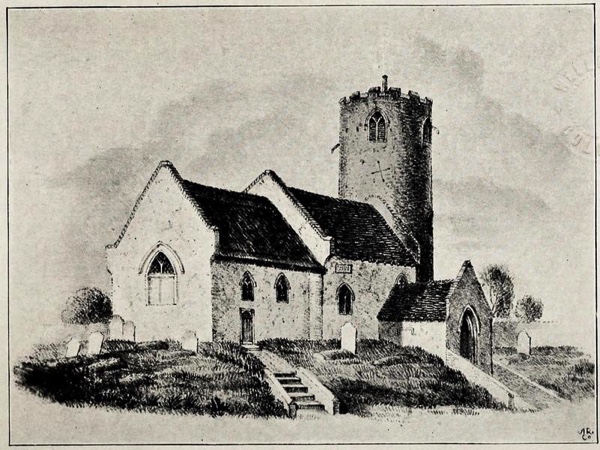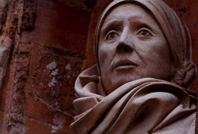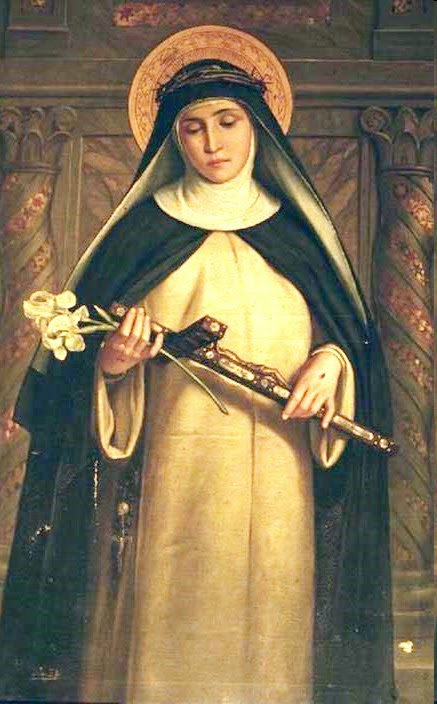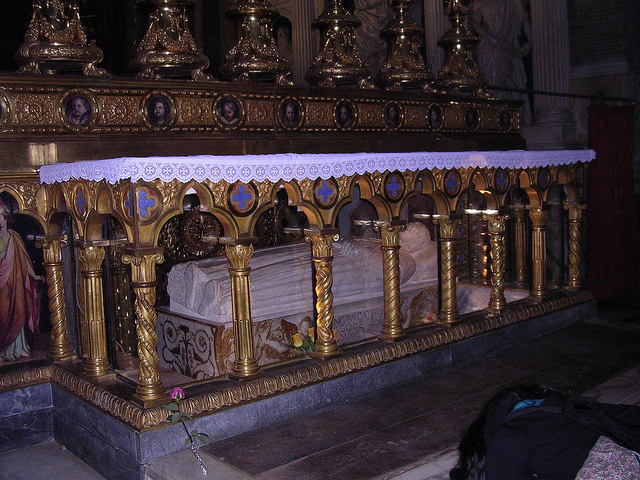(Chapter 1) Treats of the beauty and dignity of our souls; makes a comparison by the help of which this may be understood; describes the benefit which comes from understanding it and being aware of the favours which we receive from God; and shows how the door of this castle is prayer.*
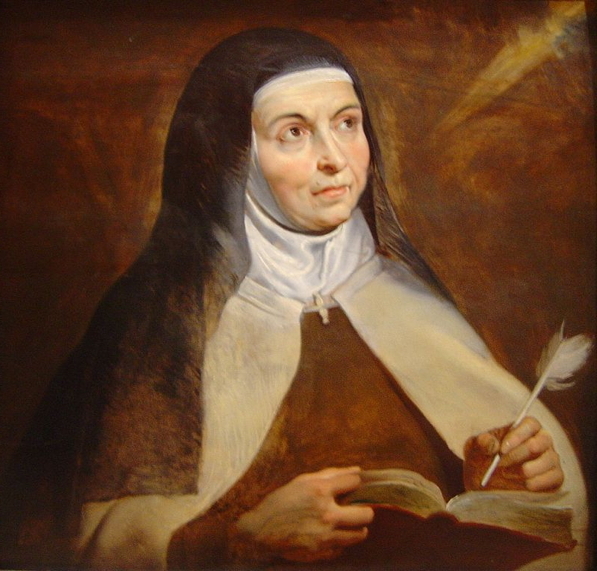 Teresa de Cepeda y Ahumada was born on March 28, 1515 in Avila, Spain to mother Beatriz, a member of the nobility, and Don Alonso Sanchez de Cepeda who was a successful merchant. Don Alonso had two children from a previous marriage. He and Beatriz had ten more children. The children were all highly educated; Beatriz loved to read and Don Alonso had an extensive library that included many classics as well as theological books. Teresa took advantage of this library and became very learned. In November, 1528, when Teresa was thirteen, her mother died.
Teresa de Cepeda y Ahumada was born on March 28, 1515 in Avila, Spain to mother Beatriz, a member of the nobility, and Don Alonso Sanchez de Cepeda who was a successful merchant. Don Alonso had two children from a previous marriage. He and Beatriz had ten more children. The children were all highly educated; Beatriz loved to read and Don Alonso had an extensive library that included many classics as well as theological books. Teresa took advantage of this library and became very learned. In November, 1528, when Teresa was thirteen, her mother died.
By the late fifteenth century the Spanish Inquisition had started. Ferdinand and Isabella (the king and queen who later gave Christopher Columbus his ships) were trying to unite Spain on ethnic and religious purity of blood. Teresa’s paternal grandfather, Juan Sanchez, was a Jew who had been forced to convert to Christianity. In 1485 he was accused of backsliding and was forced to endure humiliating punishment. In order to get away from this conflict Teresa’s family moved to Avila. There they were very financially successful.
Teresa was a vivacious and precocious child. When she was seven years old she and her brother ran away to try to convert Muslims. This was quite dangerous but fortunately a relative saw them and returned them home. During her teen years she gave up her piety and turned to frivolity. She engaged in such flirtatious behavior that her father sent her to an Augustinian convent for eighteen months. When she became ill in 1532 she returned home to recover. Afterwards she decided to enter the Carmelite house of the Encarnation, taking the veil in 1536.
This convent was very popular with the daughters of the wealthy. Teresa was able to live there with family members and friends and servants. She lived in some of the best quarters and ate good food. She was free to come and go. She could return home to visit family or recuperate from illness. This is not our usual picture of convents with their solitude, silence and prayer. Later Teresa would question the laxness of her convent and become desirous of reform for Encarnation.
After another serious illness in 1538, Teresa’s spiritual life deepened. She spent her time reading spiritual books while convalescing at the uncle’s home. She began to take her relationship with God seriously. She thought of God now in terms of friendship and love. She would later say that the presence of God within the human person was as a taste of heaven on earth.
She returned to the convent but then experienced such a serious illness that she was in a coma. Everyone thought she was dying. She recovered gradually, living with partial paralysis for three years. Again Teresa used her time to grow deeper in her relationship with God. She then went home to nurse her father until his death in 1543.
For the next ten years Teresa experienced tremendous spiritual growth. She  began to have mystic visions. She tried to be cautious about telling others; some people assumed that all visions were demonic. But Teresa’s visions led her to do something about reforming the Encarnation. She desired to turn the convent into a place of piety, prayer, and community. Teresa’s visions also led to love for the poor and a willingness to serve others in Christian service.
began to have mystic visions. She tried to be cautious about telling others; some people assumed that all visions were demonic. But Teresa’s visions led her to do something about reforming the Encarnation. She desired to turn the convent into a place of piety, prayer, and community. Teresa’s visions also led to love for the poor and a willingness to serve others in Christian service.
Teresa’s first reformed convent, St. Joseph’s, opened up in 1562. The same year Teresa started writing “The Book of Her Life”. She also completed a Constitution to be used by the reformed convents.
Another problem that Teresa had to surmount was the fact that she was a woman. The Jesuit men confiscated her book during the Inquisition and held onto it until after her death, where it eventually found its way into the library of Philip II. Many people who loved her made copies and circulated them.
Like Catherine of Siena for Italy, Bridgett of Sweden, and Julian of Norwich, Teresa was an innovator for Spain. She was one of the first to write modern Spanish literature. She was a creative theologian; beatified by Pope Paul V in 1614; canonized by Pope Gregory XV in 1622; and made a Doctor of the Church by Pope Paul VI in 1970, the first woman to be given that honor in the Roman Catholic Church.
Teresa’s works include: “The Book of Her Life”; “Spiritual Testimonies and Soliloquies”; “Constitutions and On Making the Visitation”; “The Way of Perfection”; “The Interior Castle”; “Meditations on the Song of Songs”; and ”The Book of Her Foundations”.
Teresa wrote “The Interior Castle” in 1577. This book is well regarded by Protestants and Catholics alike as one of the most celebrated books on mystical theology in existence. It is considered to be Teresa’s most mature work and expresses the depth of her experience in guiding souls to a deeper relationship with God through prayer.
Besides the mystical content, Teresa writes an abundance of good advice on how to live as a human being in relation to God and others. She encourages the spiritual traits of self-examination, humility, progress in virtue, and grace. She aspired to evermore closeness to the Father and Christ with the help of the Holy Spirit, and longs for her sisters to know the same joy.
The central motif of “The Interior Castle” is that of a “castle made of a single diamond … in which there are many rooms, just as in Heaven there are many mansions.”
The door by which one enters the castle is prayer and meditation. Once inside, the seeker is called to cultivate self-knowledge and humility before entering the rooms. It is the only way to spiritual progress. Pride will keep the soul from experiencing deeper fellowship with God.
The first set of mansions begins with a meditation on the excellence and dignity of the human soul, because it is made in the image and likeness of God. The souls are encouraged to spend as long as needed here in the Mansions of Humility.
In the second set of mansions, the soul matures as it seeks every opportunity to grow spiritually. Sermons, edifying conversation and good company are resources for maturing. Much time should be spent in the Mansion of Prayer.
In the third set of mansions, the Mansions of Exemplary Life, the soul learns to trust more in God and not to lean on their own strength and the virtues they have already acquired. Discipline, penance and charitable works are enjoined on the seekers.
In the fourth set of mansions, the soul learns to make God’s part increase more and more in their lives. Their soul is like a fountain built near a source of water. God gives the water of life.
In the fifth set of mansions the soul is able to reach a new level of prayer and contemplation. In the sixth set of mansions, a deep intimacy with the Lord is developed. In the seventh mansion, the soul reaches the “Spiritual Marriage” with the King. There is complete transformation and perfect peace. No higher state is conceivable until one reaches Heaven.
Teresa invited her sisters to enter the Interior Castle to move toward a life of prayer and contemplation, love and closeness to the Savior. Today we are invited to be in awe of the truth that God can make His presence real to us. We are in this castle together and as we become transformed by a life of prayer and love for God it should lead to works of charity and social action.
“May today there be peace within.
May you trust God that you are exactly where you are meant to be.
May you not forget the infinite possibilities that are born of faith.
May you use those gifts that you have received, and pass on the love that has been given to you.
May you be content knowing you are a child of God.
Let this presence settle into your bones, and allow your soul the freedom to sing, dance, praise and love.
It is there for each and every one of us.” (Teresa of Avila)
*St. Teresa of Avila applied the figure of a castle to the life of prayer, which is also the life of virtue. She illustrates this in her “Interior Castle” (Written in 1577). This quote is the heading to chapter 1, “First Mansions”.
